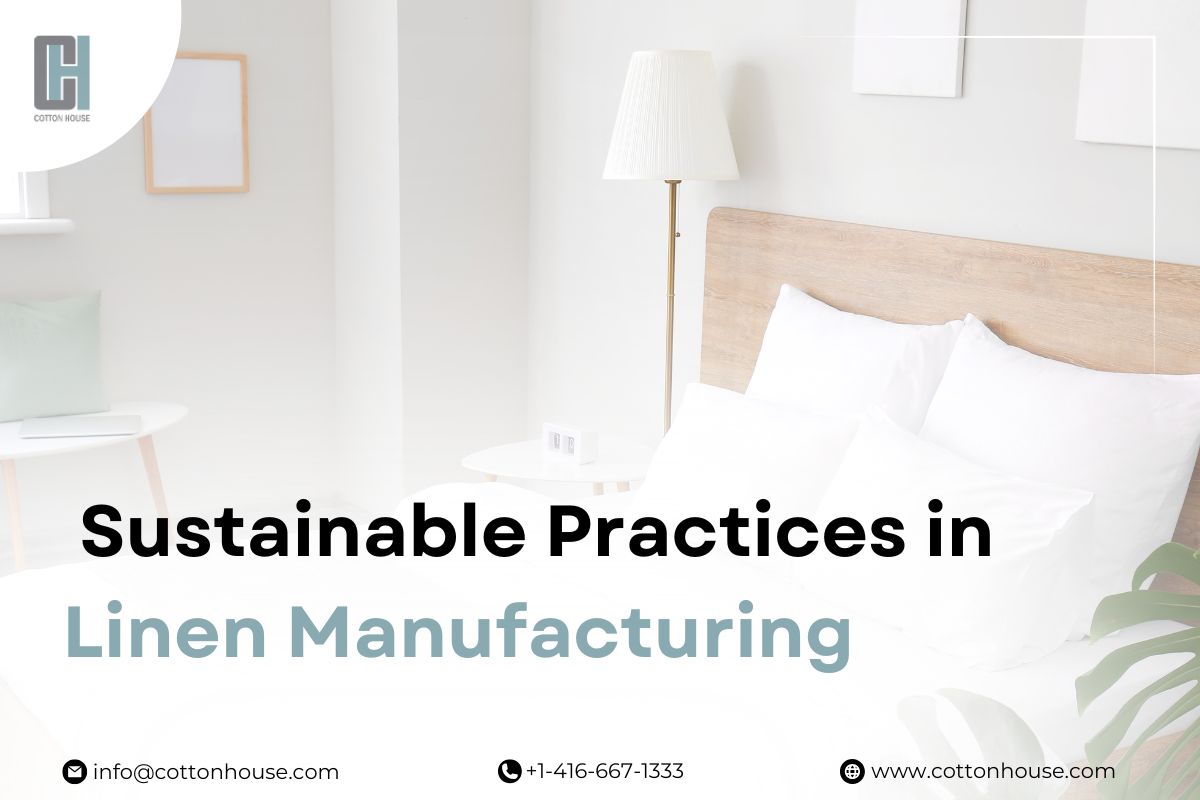
Linen has become the go-to fabric for conscious consumers, and it’s easy to see why. Known for its durability, breathability, and classic look, linen also leads the way in sustainable textile production. But what exactly are the sustainable practices in linen manufacturing that make it a better choice for people and the planet?
In this blog, we’ll explore how linen is made sustainably, the eco-friendly linen production methods leading manufacturers use, and what buyers should look for when choosing environmentally friendly fabric choices—especially for industries like hospitality and retail.
What Makes Linen an Eco-Friendly Fabric?
It all starts with flax. Linen is made from the flax plant, which grows naturally with minimal need for irrigation or pesticides. In fact, flax can thrive in poor soil and requires up to 60% less water than cotton, making it a standout choice in the green practices in textile industry.
What’s more, linen is fully biodegradable and long-lasting. Unlike synthetic materials that shed microplastics, linen decomposes naturally without leaving a trace. Its natural durability also means products made from linen—such as bedding or towels—can last for years, reducing the need for frequent replacements. These qualities make linen one of the most environmentally friendly fabric choices available today.
Also Read: Top Bedding Choices for Hotels and Resorts
Key Sustainable Practices in Linen Manufacturing:
To understand why linen is a leader in eco-conscious textiles, let’s break down the core sustainable practices in linen manufacturing that responsible producers are following:
1. Organic and Regenerative Flax Farming:
At the heart of sustainable linen is organic flax linen. Unlike conventional farming, organic practices avoid synthetic pesticides and fertilizers, which can pollute waterways and degrade soil. Even better, regenerative farming methods help restore soil health, improve carbon capture, and support local biodiversity—offering more than just the basic organic flax linen benefits.
2. Closed-Loop Water and Chemical Usage:
A big concern in textile production is water pollution from dyes and chemical treatments. That’s why many manufacturers now use closed-loop systems that reuse water and reduce harmful runoff. In addition, low-impact dyes and natural finishes are used in eco-friendly linen production, helping keep the process clean and safe.
3. Energy-Efficient Processing:
Another vital part of sustainable linen manufacturing is reducing energy consumption. Some manufacturers rely on renewable sources like solar energy or use low-energy machinery for processing and drying. Innovations like these significantly reduce the carbon footprint of the production line.
4. Ethical Labor and Local Sourcing:
Sustainability isn’t just about the environment—it’s also about people. Brands committed to green practices in textile industry prioritize safe working conditions, fair wages, and local supply chains. Sourcing flax from nearby farms helps reduce transport emissions and supports rural communities.
5. Waste Reduction and Recyclability:
From using every part of the flax plant to repurposing production offcuts, zero-waste practices are central to responsible linen manufacturing. Many brands are also switching to recyclable or compostable packaging to minimize landfill waste.
These innovations ensure sustainable practices in linen manufacturing extend from the field all the way to the final product.
Also Read: The Best 5 Bedding Materials for People with Skin Allergies: A Comprehensive Guide
How Brands Can Ensure Transparency and Certification:
It’s one thing to claim eco-friendliness—but proving it is another. That’s why third-party certifications are so important. Look for certifications like:
- GOTS (Global Organic Textile Standard)
- OEKO-TEX®
- European Flax®
These labels ensure that the linen was produced using eco-friendly linen production methods and that social and environmental standards were met throughout the supply chain. Brands working with trusted bed linen suppliers in Toronto and other ethical regions often provide transparency through traceability and blockchain technology.
The Impact on Consumers and the Environment:
Choosing linen made through sustainable linen manufacturing practices benefits more than just the earth. Consumers receive products that are healthier for their skin, free from harsh chemicals, and longer-lasting than many synthetic alternatives.
This is especially relevant in industries like hospitality, where quality and durability are top priorities. Linen is considered the best bedding for hotels due to its ability to withstand repeated washing, maintain comfort, and offer a luxurious, breathable feel.
By supporting environmentally friendly fabric choices, consumers and businesses alike help reduce demand for polluting materials, limit landfill waste, and support a cleaner textile industry.
Also Read: The Benefits of Buying Bedding in Bulk from a Wholesale Supplier
Future of Sustainable Linen Manufacturing
Innovation continues to push linen into the future. Research is underway into how linen is made sustainably using even more efficient techniques—like waterless dyeing, AI-powered supply chain tracking, and smart farming.
There’s also growing interest in circular textile economies where worn-out linens are broken down and reprocessed into new fabric. This shift toward full-cycle sustainability could revolutionize not just linen, but the entire textile industry. Expect to see green practices in textile industry expand as more consumers demand traceable, high-quality, and eco-friendly options.
Final Thoughts – Linen That’s Gentle on the Planet
At the end of the day, sustainable practices in linen manufacturing are not just a trend—they’re a necessity. From the flax field to the finished product, every step in the process impacts the planet. By choosing organic flax linen, supporting ethical brands, and working with reputable bed linen suppliers in Toronto, both businesses and individuals can take meaningful steps toward sustainability.
Whether you’re sourcing for your home or looking for the best bedding for hotels, linen produced with integrity offers unmatched value. It’s time we look beyond the thread count—and start counting the impact.
🙋 FAQs
What makes linen more sustainable than cotton?
Linen requires less water, fewer pesticides, and is biodegradable—making it far more eco-friendly than cotton.
How is sustainable linen manufactured?
Through organic farming, low-impact processing, ethical labor, and waste-reduction methods that prioritize environmental health.
What certifications should I look for in eco-friendly linen?
Look for GOTS, OEKO-TEX®, and European Flax® certifications to ensure ethical and sustainable sourcing and production.
Is organic linen better for the environment?
Yes. Organic linen avoids harmful chemicals and supports regenerative agriculture, offering both environmental and health benefits.



